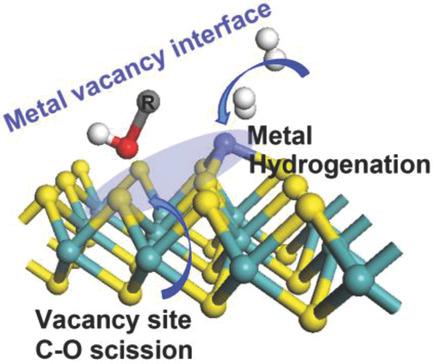当前位置:
X-MOL 学术
›
Small Methods
›
论文详情
Our official English website, www.x-mol.net, welcomes your feedback! (Note: you will need to create a separate account there.)
Forming Atom–Vacancy Interface on the MoS2 Catalyst for Efficient Hydrodeoxygenation Reactions
Small Methods ( IF 12.4 ) Pub Date : 2018-09-27 , DOI: 10.1002/smtd.201800315 Qiang Li 1 , Xiaowan Bai 1 , Chongyi Ling 1 , Qionghua Zhou 1 , Shijun Yuan 1 , Qian Chen 1 , Jinlan Wang 1
Small Methods ( IF 12.4 ) Pub Date : 2018-09-27 , DOI: 10.1002/smtd.201800315 Qiang Li 1 , Xiaowan Bai 1 , Chongyi Ling 1 , Qionghua Zhou 1 , Shijun Yuan 1 , Qian Chen 1 , Jinlan Wang 1
Affiliation

|
Atomically dispersed supported catalysts show superior catalytic activity and selectivity in diverse reactions, while the challenging part is identifying the active sites and revealing the reaction mechanisms, which play essential roles in rational design of efficient catalysts to massive energy consumption reduction. Herein, an atom vacancy interface (AVI) model is proposed, for the first time, based on a case study of atomically dispersed Co atoms distributed on 2H‐MoS2 surfaces as promising catalysts for hydrodeoxygenation (HDO) reactions. The results show that the reactive single Co atom promotes the H2 activation and leads to largely increased sulfur vacancies adjacent to the metals and the formation of metal vacancy interfaces on the MoS2 surface. Detailed reaction mechanism studies demonstrate that the AVI model is quite different from edge vacancy dominated unprompted MoS2 and traditionally prepared CoMoS2 catalysts. The novel structure results in a considerable reduction of energy barriers of three elementary steps including CO scission, hydrogenation processes, and catalytic center regeneration, and eventually boots the HDO reaction at low temperature.
中文翻译:

在MoS2催化剂上形成原子-空位界面以进行有效的加氢脱氧反应
原子分散的负载型催化剂在各种反应中均显示出优异的催化活性和选择性,而具有挑战性的部分是确定活性位点并揭示反应机理,这在合理设计高效催化剂以降低能耗方面起着至关重要的作用。在此,首次以原子分散的Co原子分布在2H-MoS 2表面作为加氢脱氧(HDO)反应的有前景催化剂为例,首次提出了原子空位界面(AVI)模型。结果表明,反应性单个Co原子促进H 2活化并导致与金属相邻的硫空位大大增加,并在MoS 2上形成金属空位界面表面。详细的反应机理研究表明,AVI模型与以空位为主的无提示MoS 2和传统制备的CoMoS 2催化剂完全不同。新颖的结构导致的显着降低的三个基本步骤,包括C能量壁垒 Ò断链,氢化过程,和催化中心再生,并最终靴在低温下反应HDO。
更新日期:2018-09-27
中文翻译:

在MoS2催化剂上形成原子-空位界面以进行有效的加氢脱氧反应
原子分散的负载型催化剂在各种反应中均显示出优异的催化活性和选择性,而具有挑战性的部分是确定活性位点并揭示反应机理,这在合理设计高效催化剂以降低能耗方面起着至关重要的作用。在此,首次以原子分散的Co原子分布在2H-MoS 2表面作为加氢脱氧(HDO)反应的有前景催化剂为例,首次提出了原子空位界面(AVI)模型。结果表明,反应性单个Co原子促进H 2活化并导致与金属相邻的硫空位大大增加,并在MoS 2上形成金属空位界面表面。详细的反应机理研究表明,AVI模型与以空位为主的无提示MoS 2和传统制备的CoMoS 2催化剂完全不同。新颖的结构导致的显着降低的三个基本步骤,包括C能量壁垒 Ò断链,氢化过程,和催化中心再生,并最终靴在低温下反应HDO。



























 京公网安备 11010802027423号
京公网安备 11010802027423号